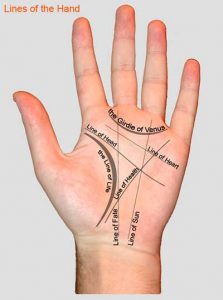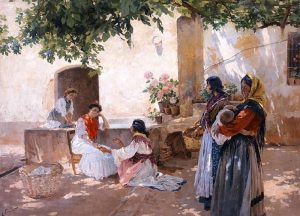DESPITE persecution with the ascendency of Christianity, Palmistry, the ancient art of foretelling one’s future by interpreting the lines in the palm, has survived. But in Guyana, little is known about the mysticism.The root of Palmistry can be traced to Indian (Hindu) Astrology (known in Sanskrit as Jyotish) and Roma (gypsy) fortune tellers.
The Hindu sage, Valmiki is thought to have written a book, whose title translates in English as “The Teachings of Valmiki Maharshi on Male Palmistry”. Comprising of 567 stanzas, it was penned more than 5,000 years ago.
From India, the mystical art spread to China, Tibet, Egypt, Persia and to other countries in Europe.
Today, Palmists often combine traditional predictive techniques with psychology, holistic healing, and alternative methods of divination.
Pandit Deodatt Muridall Tillack told the Guyana Chronicle that though Palmistry is an integral part of Hindu Astrology, much attention has not been devoted to it.
He said the art is the study of the lines of the palm, the position of the celestial bodies: Saturn, Mars, Jupiter, Mercury etcetera, and the impact they can possible have in one’s lives.
The priest, who is also a Clinical Psychologist, explained that Palmistry is not a precise science, pointing out that it serves as a guide to one’s future.
In the Indian culture, he said, it is preferable that the right hand of men be read as it generally represents dominance, and the left hand of women, which is equal in stature to men, but more characterises a supporting nature.
However, if the dominant hand of a man is his left hand, it would be advisable that that hand be read instead of his right hand.
The thickness, shape and flexibility of the lines of the palm, he said tells a story about a person’s mood, tendencies, personality traits, and possible ups and downs in life and when they are likely to occur.
Pandit Tillack told this publication that in short, the palm in Hinduism serves somewhat as a map of a person’s future; the story is told through intricate lines; and play the role of a compass, it points to major events that are likely to happen.
CATEGORY OF HANDS
There are four categories of hands, he said, noting that these are Air, Earth, Water and Fire.
The Air Hand, he said, is square in shape with long figures, and is representative of persons who are vocal in their beliefs, intellectually curious and emotionally stable.
The Earth Hand is also recognised by its close squareness, but short fingers, and tells of a person who is generally physically strong, perseveres and hardworking.
The Water Hand is a rectangular palm with long fingers and characterises persons who are sensitive, flexible, creative and emotional, while the Fire Hand is also rectangular in outline, but with short fingers.
Persons with this hand shape tend to be verbally and physically aggressive, always hyped, and at times mean well but are misunderstood.
According to Pandit Tillack, based on the wisdom of sacred Hindu scriptures, a person’s openness is usually determined by the thumb.
He explained that if the thumb of an outstretched hand passes the base and the first ring of the index finger, the subject is confident and assertive in character.
A thumb that is below or just above the base of the index finger, the priest said, is representative of a person who is shy and introverted.
In interpreting the palm, he said the astrological significance of the fingers is important.
According to him, the index finger represents the planet Jupiter, which is Brhaspati, the teacher of the gods. The middle finger is a representation of the planet Saturn, intellect and the god Shani, who brings difficulty in one’s lives.
These can be counteracted by the wearing of a gold ring with a sapphire stone, which, according to Pandit Tillack, has magnetic quality, nullifying negative effects of the solar universe.
The ring finger represents the Sun, Surya, the head of the solar system. It is said to have a vein running all the way to the heart, and represents matters of the heart as well as energy, health and material wealth.
The little figure, the priest said, falls in the region of the planet Mercury and is indicative of persons who are hot tempered but eloquent, persuasive, seductive and yet mild in nature.
LINES
In the palm, there are several noticeable lines. The Heart Line, which is situated at the top of the palm; the Head Line which is below the Heart Line; the Life Line, which joins to the Head Line; the Fate Line, which starts at the base of the palm, and extends in the direction of the middle finger; the Fame Line, which starts at the left of the Fate Line and goes in the direction of the ring finger; and the Love Lines, which are situated at the side on the top right of the palm.
The Heart Line, Pandit Tillack explained, speaks mainly of a person’s attraction and emotion. A long line indicates an idealistic partner; a deep line a stressful life; a faint line a weak heart; a straight line intense feelings; and a broken line a troubled relationship.

The Head Line represents intellect and reasoning. A long line indicates ambition; a short one intelligence and intuitiveness; a deep line excellent memory; and a straight line a person who is materialistic in nature.
The Life Line, the priest related, speaks of life in general. A straight line signifies good health; a short line, a short life; a deep line, a smooth life; and a fainted line, low energy. Deep strokes on the Life Line indicate major events in a person’s life.
The Fate Line speaks of a person’s destiny. A fainted line indicates disappointment; a broken line, difficult circumstances; and a chained line, highs and lows in life.
The Fame Line is not present in everyone’s hands but it speaks of brilliance and outstanding artistic abilities, while the Love Lines gives insight into a person’s love life.
A fragmented line foretells of troubled relationships; a deep groove, a long-lasting relationship; small or fainted lines, children born out of relationships; and the spacing of the lines, the time span of the different relationships.
According to Pandit Tillack, at the point the Life Line connects with the Faith Line, tells of the possible time a person will discover his/her real purpose in life. If there is no connection, there is a strong indication that the person will live his entire life without discovering his real purpose.
The area within the thumb and the Life Line, he said, represents Venus and to an extent speaks to one’s sexual preferences. According to him, if the Life Line connects with the Fate Line and reaches a V at the base of the middle finger, it signifies that the subject has homosexual tendencies.
There are many tales of palmistry. Greek Philosopher Aristotle (384-348 BC), tutor to military genius, Alexander the Great was said to be a devoted palmist who imparted his knowledge to his students.
According to legend, he found an ancient palmistry scroll on an Arabic alter and presented it to Alexander, his pupil.
Pandit Tillack told the Guyana Chronicle that Hindus believe that the sacred knowledge of the palm was imparted by the god of the ocean, Varuna. Knowledge of the palm can also be found in the sacred texts Hasta Sajeenani and the Bhavishya Purana.
He said he was taught the sacred knowledge by his guru, Pandit Tulsi Ram Chowbay, but also learned a great lot from his own reading.
Pandit Tillack holds a Bachelor’s of Science Degree in Clinical Psychology from the American Peace University, Sheriff Street, Georgetown.
He is a member of the Inter-Religious Organisation, and serves on the Prison Security Management Board.
He is also a life coach, guidance and domestic violence counsellor, and peer educator. The priest said he has a passion working to arrest the prevalence of suicide in Guyana and dedicating his energies in helping persons to develop spiritually.
By Tajeram Mohabir



.jpg)








